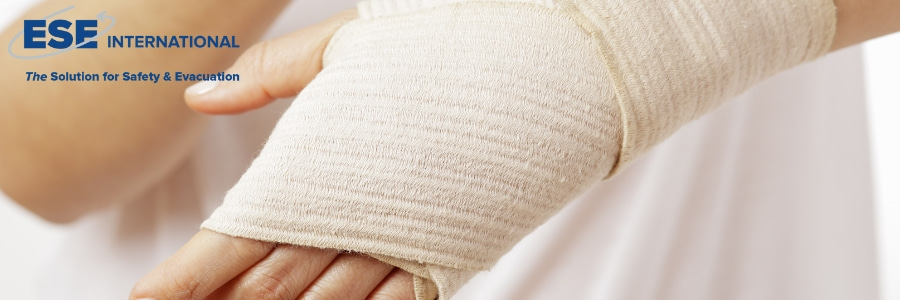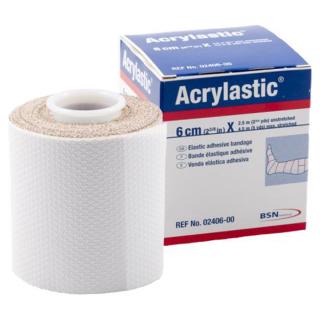Zwachtels zijn een veelzijdig verbandmiddel die in de eerste hulp en medische zorg veel worden gebruikt. Zwachtels worden gebruikt om verwondingen te verbinden, druk uit te oefenen op een wond en om gewrichten te ondersteunen.
Wat is een zwachtel?
Een zwachtel is een lange strook stof (textiel) die gebruikt wordt om wonden, blessures en vochtophoping te behandelen. Zo is een zwachtel onderdeel van een drukverband en wonddrukverband.
Waarvoor gebruik je een zwachtel?
Een zwachtel heeft verschillende toepassingen, waaronder:
- Ondersteunen van gewrichten: Bij verstuikingen en kneuzingen wordt de zwachtel gebruikt om stabiliteit te bieden en verdere schade te voorkomen.
- Bevorderen van wondgenezing: Hierbij wordt een zwachtel gebruikt om het gaasverband op zijn plaats te houden en de wond te beschermen tegen vuil en bacteriën.
- Verminderen van zwelling: Door druk uit te oefenen op het getroffen gebied kan een zwachtel helpen om zwelling te verminderen bij verzwikkingen en verstuikingen.
- Bevestigen van ijs- of warmtepakkingen: Om therapeutische kou of warmte op een blessure aan te brengen.
- Compressietherapie: Hierbij wordt een zwachtel gebruikt om vochtophoping (oedeem) te verminderen.
- Immobilisatie: Hierbij wordt een zwachtel gebruikt om de beweging van een lichaamsdeel of gewricht te beperken. Meestal om het genezingsproces te bevorderen.
Van welk materiaal is een zwachtel gemaakt?
Zwachtels kunnen van verschillende materialen worden gemaakt, afhankelijk van hun specifieke gebruik:
- Katoen: Katoen is ademend en zacht, ideaal voor gebruik direct op de huid.
- Elastische stoffen: Deze bevatten vaak latex of spandex, wat rekbaarheid en compressie biedt.
- Synthetische vezels: Zoals nylon of polyester, die duurzaamheid en langdurige ondersteuning bieden. Daarnaast vaak ook waterafstotend zijn.
Bij sommige behandelingen wordt een combinatie van verschillende zwachtels gebruikt.
Welke soorten zwachtels heb je?
Er zijn diverse soorten zwachtels, elk ontworpen voor specifieke toepassingen:
- Gaaszwachtels: dunne, ademende zwachtels die worden gebruikt om gaasverbanden op hun plaats te houden.
- Ideaal zwachtel: een ideaal zwachtel/windsel van 100% katoen dat niet elastisch is. De zwachtel rafelt niet en wordt gebruikt voor wond- en drukverband.
- Katoenen zwachtels: dik en absorberend, ideaal voor algemene verbanddoeleinden.
- Lange rek zwachtels: lange rek zwachtels zijn zeer elastische zwachtel die constante druk geeft op een ledemaat. Deze zijn voornamelijk voor ledematen die niet meer in beweging zijn.
- Korte rek zwachtels: korte rek zwachtels zijn elastische zwachtels die gebruikt worden bij ledematen die nog mobiel zijn. Zo verhoogt de zwachtel de druk bij beweging en verlaagd de druk als een lichaamsdeel niet in beweging is.
- Elastische zwachtels: ook bekend als rekverband, gebruikt om compressie en steun te bieden.
- Zelfklevende zwachtels: deze zwachtels kleven/hechten aan zichzelf, maar niet aan huid of haar, wat ze ideaal maakt voor snelle en gemakkelijke toepassing. Ook wel cohesieve zwachtels genoemd.
- Compressiezwachtels: specifiek ontworpen om gelijkmatige druk uit te oefenen en worden vaak gebruikt bij de behandeling van chronische veneuze insufficiëntie of lymfoedeem.
- Hydrofiele zwachtels: elastisch hydrofiele zwachtels zijn ontworpen om vocht vast te houden, wat nuttig is bij de behandeling van brandwonden of zeer droge huid.
Disclaimer: Dit artikel is bedoeld voor informatieve doeleinden en vervangt geen professionele medische hulp. Bij ernstige verwondingen of twijfels, raadpleeg een gekwalificeerde BHV’er. Indien er sprake is van ernstige verwondingen, bel 112 of ga direct naar de dokter.






